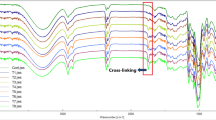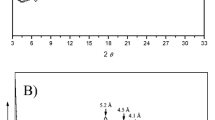Abstract
In this study, films from cassava starch and rosemary oil were prepared by using the casting method. Glycerol was used as plasticizer and tween 80 as surfactant. The influence of Cassava starch (Cs), Rosemary oil (Ro), Surfactant (Sf) concentrations and Thickness of film (Tf) on the mechanical, optical, and barrier properties of cassava starch films was studied applying the Response Surface Methodology. The response variables were optimized by using second order polynomial models with satisfactory fit and coefficient of determination (R2) values (> 81%). The optimized conditions with the goal of maximizing mechanical properties and minimizing barrier and optical properties and desirability function (0.9796) were Cs = 3 g/100 g solution, Ro = 4 g/100 g Cs, Sf = 69 g/100 g Ro and Tf = 0.05 ± 0.001 mm. The films produced under these conditions displayed high mechanical strength (16.7 MPa), young´s modulus (2911.4 MPa), low elongation at break (0.2%), low water vapor transmission (0.8 × 10−14 g/Pa s m), low solubility (33.24%), and low opacity (16%). These results provided good mechanical, barrier, and optical properties, compared to films based on other starch resources.





Similar content being viewed by others
References
Gutiérrez TJ, Álvarez K (2016) Physico-chemical properties and in vitro digestibility of edible films made from plantain flour with added Aloe vera gel. J Funct Foods 26:750–762
Podshivalov A, Zakharova M, Glazacheva E, Uspenskaya M (2017) Gelatin/potato starch edible biocomposite films: correlation between morphology and physical properties. Carbohydr Polym 157:1162–1172
Tian H, Yan J, Rajulu AV, Xiang A, Luo X (2017) Fabrication and properties of polyvinyl alcohol/starch blend films: effect of composition and humidity. Int J Biol Macromol 96:518–523
Debiagi F, Kobayashi RKT, Nakazato G, Panagio LA (2014) Biodegradable active packaging based on cassava bagasse, polyvinyl alcohol and essential oils. Ind Crop Prod 52:664–670
Mukurumbira AR, Mellem JJ, Amonsou EO (2017) Effects of amadumbe starch nanocrystals on the physicochemical properties of starch biocomposite films. Carbohydr Polym 165:142–148
Ghasemlou M, Aliheidari N, Fahmi R, Shojaee-Aliabadi S (2013) Physical, mechanical and barrier properties of corn starch films incorporated with plant essential oils. Carbohydr Polym 98:1117–1126
Medina C, Gutiérrez TJ, Goyanes S, Bernal C, Famá L (2016) Biodegradability and plasticizing effect of yerba mate extract on cassava starch edible films. Carbohydr Polym 151:150–159
Xie F, Pollet E, Halley PJ, Avérous L (2013) Starch-based nano-biocomposites. Prog Polym Sci 38:1590–1628
Acosta S, Chiralt A, Santamarina P, Rosello J (2016) Antifungal films based on starch-gelatin blend, containing essential oils. Food Hydrocoll 61:233–240
Kenny M, Peponi L, Sessini V, Arrieta MP (2016) Processing of edible films based on nanoreinforced gelatinized starch. Polym Degrad Stab 132:157–168
Liu B, Xu H, Zhao H, Liu W, Zhao L, Li Y (2017) Preparation and characterization of intelligent starch / PVA films for simultaneous colorimetric indication and antimicrobial activity for food packaging applications. Carbohydr Polym 157:842–849
Mohammad S, Hashemi B, Mousavi A (2017) Characterization of novel basil-seed gum active edible films and coatings containing oregano essential oil. Prog Org Coatings 110:35–41
Souza AC, Goto GEO, Mainardi JA, Coelho ACV, Tadini CC (2013) Cassava starch composite films incorporated with cinnamon essential oil: antimicrobial activity, microstructure, mechanical and barrier properties. LWT 54:346–352
Ruiz-Navajas Y, Viuda-Martos M, Sendra E, Perez-Alvarez JA, Fernández-López J (2013) In vitro antibacterial and antioxidant properties of chitosan edible films incorporated with Thymus moroderi or Thymus piperella essential oils. Food Control 30:386–392
Pranoto Y, Rakshit SKÃ, Salokhe VM (2005) Enhancing antimicrobial activity of chitosan films by incorporating garlic oil, potassium sorbate and nisin. LWT 38:859–865
Saberi B et al (2016) Optimization of physical and optical properties of biodegradable edible films based on pea starch and guar gum. Ind Crop Prod 86:342–352
Wood DF, Velazquez G (2016) Physical characterization of biodegradable films based on chitosan, polyvinyl alcohol and Opuntia mucilage. J Polym Environ 25:683–691
ASTM. Standard Test Method for Tensile Properties of Thin Plastic Sheeting 1. no. C. pp. 1–10. (2010)
Farahnaky A, Saberi B, Majzoobi M (2013) Effect of glycerol on physical and mechanical properties of wheat starch edible films. J Texture Stud 44:176–186
Daudt RM et al (2016) Comparative study on properties of edible films based on pinhão (Araucaria angustifolia) starch and flour. Food Hydrocoll 60:279–287
Castillo ED, Montgomery DC, McCarville DR (1996) Modified desirability functions for multiple response optimization. J Qual Technol 52:337–345
Chiumarelli M, Hubinger MD (2014) Evaluation of edible films and coatings formulated with cassava starch, glycerol, carnauba wax and stearic acid. Food Hydrocoll 38:20–27
Pelissari F, Andrade-Mahecha MM, José P, Cecilia F (2013) Optimization of process conditions for the production of films based on the flour from plantain bananas (Musa paradisiaca). LWT 52:1–11
Castaño J, Guadarrama-Lezama AY, Hernández J, Colín-Cruz M (2016) Preparation, characterization and antifungal properties of polysaccharide—polysaccharide and polysaccharide—protein films. J Mater Sci 52:353–366
Jiménez A, Fabra MJ, Talens P, Chiralt A (2013) Phase transitions in starch based films containing fatty acids. Effect on water sorption and mechanical behaviour. Food Hydrocoll 30:408–418
Basiak E, Lenart A, Debeaufort F (2017) Effect of starch type on the physico-chemical properties of edible films. Int J Biol Macromol 98:348–356
Biduski B et al (2017) Impact of acid and oxidative modifications, single or dual, of sorghum starch on biodegradable films. Food Chem 214:53–60
Romani VP, Prentice-Hernández C, Martins VG (2017) Active and sustainable materials from rice starch, fish protein and oregano essential oil for food packaging. Ind Crop Prod 97:268–274
Brandelero RPH, Yamashita F, Victória M, Grossmann E (2010) The effect of surfactant Tween 80 on the hydrophilicity, water vapor permeation, and the mechanical properties of cassava starch and poly (butylene adipate-co-terephthalate) (PBAT) blend films. Carbohydr Polym 82:1102–1109
Rodríguez M, Osés J, Ziani K, Maté JI (2006) Combined effect of plasticizers and surfactants on the physical properties of starch based edible films. Food Res Int 39:840–846
Fakhreddin S, Rezaei M, Zandi M, Farahmand F (2013) Preparation and functional properties of fish gelatin–chitosan blend edible films. Food Chem 136:1490–1495
Medina-jaramillo C, Alex L, Goyanes S (2017) Cassava starch films carrying rosemary antioxidant extracts for potential use as active food packaging. Food Hydrocoll 63:488–495
Colivet J, Carvalho RA (2017) Hydrophilicity and physicochemical properties of chemically modified cassava starch films. Ind Crop Prod 95:599–607
Souza AC, Benze R, Ferrão ES, Ditch C, Coelho ACV, Tadini CC (2012) Cassava starch biodegradable films: Influence of glycerol and clay nanoparticles content on tensile and barrier properties and glass transition temperature. LWT 46:110–117
Chiralt R, Villalobos, Herna P (2006) Effect of surfactants on water sorption and barrier properties of hydroxypropyl methylcellulose films. Food Hydrocoll 20:502–509
Shen XL, Min J, Chen Y, Zhao G (2010) Antimicrobial and physical properties of sweet potato starch films incorporated with potassium sorbate or chitosan. Food Hydrocoll 24:285–290
Belibi PC, Daou TJ, Ndjaka JMB, Nsom B, Michelin L, Durand B (2014) A comparative study of some properties of cassava and tree cassava starch films. Phys Procedia 55:220–226
Kavoosi G, Mohammad S, Dadfar M, Purfard AM (2013) Antimicrobial properties of gelatin films incorporated with thymol for potential use as nano wound dressing. J Food Sci 78:244–250
Navia DP, Ayala AA, Villada HS (2014) Water vapor adsorption of flour bioplastics made from two varieties of cassava (Manihot esculenta Crantz). Inf Tecnológica 25:23–32
Andrade-mahecha MM, Tapia-blácido DR, Cecilia F (2012) Development and optimization of biodegradable films based on achira flour. Carbohydr Polym 88:449–458
Abreu AS et al (2015) Antimicrobial nanostructured starch based films for packaging. Carbohydr Polym 129:127–134
Acknowledgements
This study was funded by the Universidad de San Buenaventura Cali and the national department of science, technology and innovation (Colciencias), Colombia.
Author information
Authors and Affiliations
Corresponding author
Electronic supplementary material
Below is the link to the electronic supplementary material.
Rights and permissions
About this article
Cite this article
Navia Porras, D.P., Gordillo Suárez, M., Hernández Umaña, J. et al. Optimization of Physical, Optical and Barrier Properties of Films Made from Cassava Starch and Rosemary Oil. J Polym Environ 27, 127–140 (2019). https://doi.org/10.1007/s10924-018-1316-2
Published:
Issue Date:
DOI: https://doi.org/10.1007/s10924-018-1316-2




